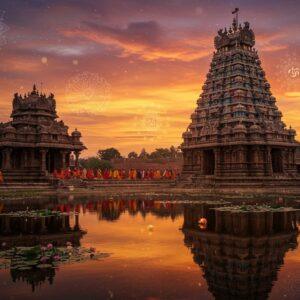
Tibetan Buddhism, a captivating blend of spiritual depth and cultural richness, has profoundly shaped Tibet’s spiritual landscape and influenced regions beyond its borders. This exploration delves into the unique beliefs, practices, and historical evolution of Tibetan Buddhism, highlighting its ability to preserve authenticity while adapting to the modern world.
Historical Roots of Tibetan Buddhism
Origins and Influential Figures
- Introduction from India: Tibetan Buddhism traces its origins back to the 7th century CE when it was introduced from India, marking a pivotal moment in Tibetan history.
- Royal Patronage: King Songtsen Gampo’s marriage to two Buddhist princesses, one from Nepal and the other from China, played a crucial role in establishing Buddhism in Tibet. He also invited scholars and translators to bring Buddhist texts and teachings to his kingdom.
- Samye Monastery: The founding of Samye Monastery in the 8th century CE solidified Buddhism’s formal presence in Tibet, establishing a center for learning and practice.
Contributions and Challenges
- Padmasambhava and Nyingma: Padmasambhava, also known as Guru Rinpoche, is credited with establishing the Nyingma school, the oldest of the four major schools of Tibetan Buddhism, known for its focus on Dzogchen teachings.
- Indian Scholars: Indian scholars like Shantarakshita and Kamalashila made significant contributions to shaping Tibetan Buddhist philosophy and practice, helping to establish a strong foundation for the tradition.
- Early Resistance: The early spread of Buddhism in Tibet faced resistance from the indigenous Bon tradition and internal conflicts, highlighting the challenges of integrating a new religion into an existing cultural context.
- The Great Debate: The Great Debate at Samye Monastery in the late 8th century CE addressed doctrinal differences between Indian and Chinese Buddhist schools, shaping the future direction of Tibetan Buddhism.
Development of Tibetan Buddhism
Major Schools
- Nyingma: This oldest school emphasizes Dzogchen, a set of teachings and practices focused on direct realization of the true nature of mind.
- Kagyu: Known for its emphasis on Mahamudra, a practice that points to the inherent emptiness and luminosity of mind, the Kagyu lineage also features unique meditation techniques.
- Sakya: The Sakya school features the Lamdre teachings, a system of graduated stages on the path to enlightenment that combines sutra and tantra practices.
- Gelug: Founded by Je Tsongkhapa, the Gelug school emphasizes monastic discipline, rigorous scholarship, and the study of logic and debate.
Key Figures and Institutions
- Atisha’s Revival: The Indian scholar Atisha played a key role in revitalizing Buddhism in Tibet during the second dissemination period in the 11th century, introducing new teachings and practices.
- Tsongkhapa and the Gelug: Je Tsongkhapa’s founding of the Gelug school in the 14th century had a lasting impact on Tibetan Buddhism, emphasizing monasticism and a structured approach to practice.
- The Dalai Lamas: The Dalai Lamas, particularly the 5th Dalai Lama, played a crucial role in unifying Tibet politically and spiritually, solidifying the Gelug school’s influence.
- Monastic Centers: Monasteries like Drepung, Sera, and Ganden became important centers of learning and practice, nurturing generations of scholars and practitioners.
Core Beliefs and Practices
Foundational Beliefs
- Four Noble Truths and Eightfold Path: Tibetan Buddhism shares the core Buddhist teachings of the Four Noble Truths, which explain the nature of suffering, and the Eightfold Path, which outlines the path to liberation.
- Samsara and Nirvana: The concepts of samsara, the cycle of birth and death, and nirvana, the state of liberation from suffering, are fundamental to Tibetan Buddhist philosophy.
Meditation Techniques
- Shamatha and Vipassana: Tibetan Buddhism incorporates various meditation techniques, including shamatha (calm abiding) and vipassana (insight), to cultivate mental stability and wisdom.
- Bodhisattva Ideal: The bodhisattva ideal, the aspiration to attain enlightenment for the benefit of all beings, is a central tenet of Mahayana Buddhism and deeply embedded in Tibetan Buddhist practice.
Rituals and Ceremonies
- Offerings and Practices: Tibetan Buddhist rituals involve various offerings, such as mandalas, prayer flags, and butter lamps, as well as chanting, prayers, and ceremonies.
- Guru Yoga: Devotion to a spiritual teacher, or guru, is considered essential in Tibetan Buddhism, with Guru Yoga practices designed to deepen the student-teacher connection.
- Tantric Practices: Tantric practices, including deity yoga and visualization, are incorporated into Tibetan Buddhism to transform ordinary experiences into paths to enlightenment.
Sacred Texts and Literature
Main Collections
- Kangyur: The Kangyur is a collection of the Buddha’s translated teachings, forming the core of Tibetan Buddhist scriptures.
- Tengyur: The Tengyur comprises commentaries and treatises by Indian and Tibetan scholars, providing further elucidation of the Buddha’s teachings.
Important Texts
- Tibetan Book of the Dead: The Tibetan Book of the Dead (Bardo Thodol) offers guidance on the process of dying, death, and rebirth, providing spiritual support during these transitional stages.
Commentarial Literature
- Key Commentators: Works by Je Tsongkhapa, founder of the Gelug school, and Longchenpa, a prominent Nyingma master, are highly regarded within Tibetan Buddhist scholarship.
- Terma: Terma refers to hidden treasures, often texts or objects, said to have been concealed by Padmasambhava and other masters to be discovered at a later time by tertöns, or treasure revealers. These terma often contain teachings and practices relevant to specific times and circumstances.
Enhance Your Tibetan Buddhist Practice with Sacred Items from Poojn.in
Poojn.in offers authentic Buddhist ritual items to support your spiritual journey. Our collection includes a beautifully crafted Lord Buddha idol made from marble dust, perfect for your meditation space or altar. This 15 cm (6″ x 4.5″) statue embodies the serene essence of Lord Buddha, serving as a focal point for mindfulness and meditation. The marble dust construction ensures durability while preserving the statue’s sacred aesthetics. Currently available at a special price, this idol is an accessible way to bring Buddhist symbolism into your home. For temples, meditation centers, or bulk orders, Poojn.in offers wholesale pricing.
Conclusion
Tibetan Buddhism offers a profound journey of beliefs and practices that have shaped the spiritual and cultural tapestry of Tibet and beyond. Its rich history, diverse schools of thought, and deep-rooted traditions continue to inspire and guide practitioners on their path to enlightenment. By understanding the core beliefs, meditation techniques, rituals, and sacred texts, we gain a deeper appreciation for the unique essence of Tibetan Buddhism. As it navigates the complexities of modern times, it retains its authenticity, offering a timeless path to spiritual growth and peace.
Tibetan Buddhism FAQs
What is Tibetan Buddhism? Tibetan Buddhism is a distinct form of Buddhism that developed in Tibet, integrating Mahayana Buddhist philosophy, Vajrayana tantric practices, and elements of the ancient Bön religion. It is characterized by its rich tapestry of rituals, deities, and lineages.
How did Tibetan Buddhism originate? Tibetan Buddhism emerged in the 7th century CE with the patronage of King Songtsen Gampo, who invited Buddhist teachers from India and initiated the translation of Buddhist scriptures into Tibetan. This marked the beginning of a long and complex process of assimilation and adaptation, resulting in the unique form of Buddhism practiced in Tibet today.
Who are some key figures in Tibetan Buddhism? Key figures include the Dalai Lama, the spiritual leader of the Gelug school, and historical figures like Padmasambhava, Milarepa, and Tsongkhapa, who founded different lineages and contributed significantly to the development of Tibetan Buddhist thought and practice.
What are the central practices of Tibetan Buddhism? Central practices include meditation (such as Shamatha-Vipashyana and deity yoga), mantra recitation, visualization, ritual offerings, and study of Buddhist scriptures. These practices aim to cultivate wisdom, compassion, and ultimately, enlightenment.
Why is meditation important in Tibetan Buddhism? Meditation plays a crucial role in Tibetan Buddhism as a means of transforming the mind, cultivating inner peace, and realizing the true nature of reality. Different forms of meditation address specific aspects of the path, from calming the mind to developing insight and cultivating compassion.
What are Tibetan Buddhist rituals? Tibetan Buddhist rituals encompass a wide range of practices, including offerings of light, incense, and water, chanting of mantras and prayers, and elaborate ceremonies performed for various purposes, such as purification, healing, and generating positive energy. These rituals often involve intricate symbolism and visualizations.
How can I delve deeper into Tibetan Buddhism? Numerous resources are available for those seeking to learn more about Tibetan Buddhism. You can explore books by renowned scholars and practitioners, attend teachings and workshops offered by Buddhist centers, and visit Tibetan Buddhist temples and monasteries to experience the tradition firsthand. Engaging with online communities and forums can also provide valuable insights and connections.
For more in-depth knowledge, you can refer to resources like the ebook “Introduction to Tibetan Buddhism” by John Powers.
Explore our diverse collection of puja kits and items at poojn.in.


